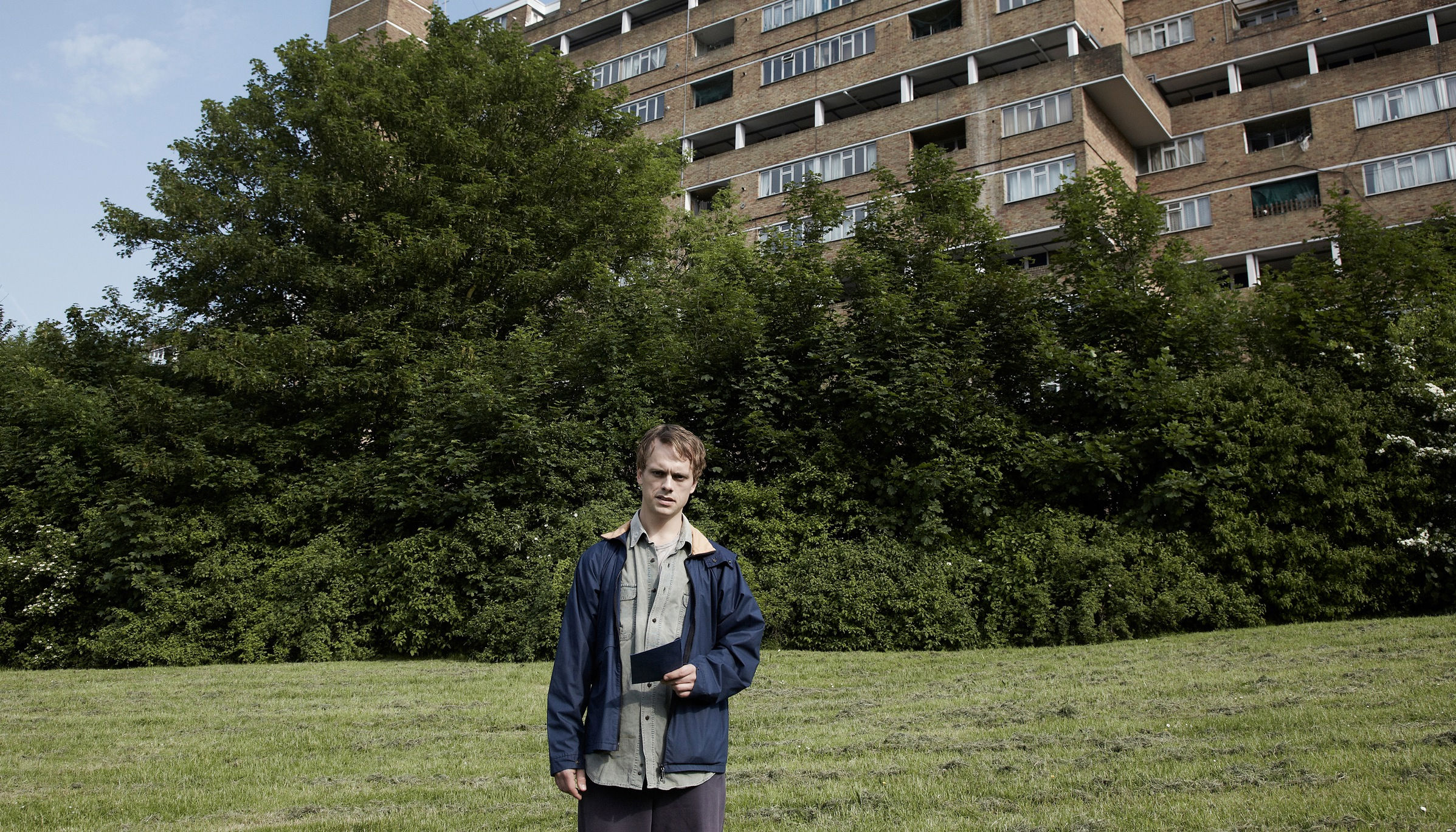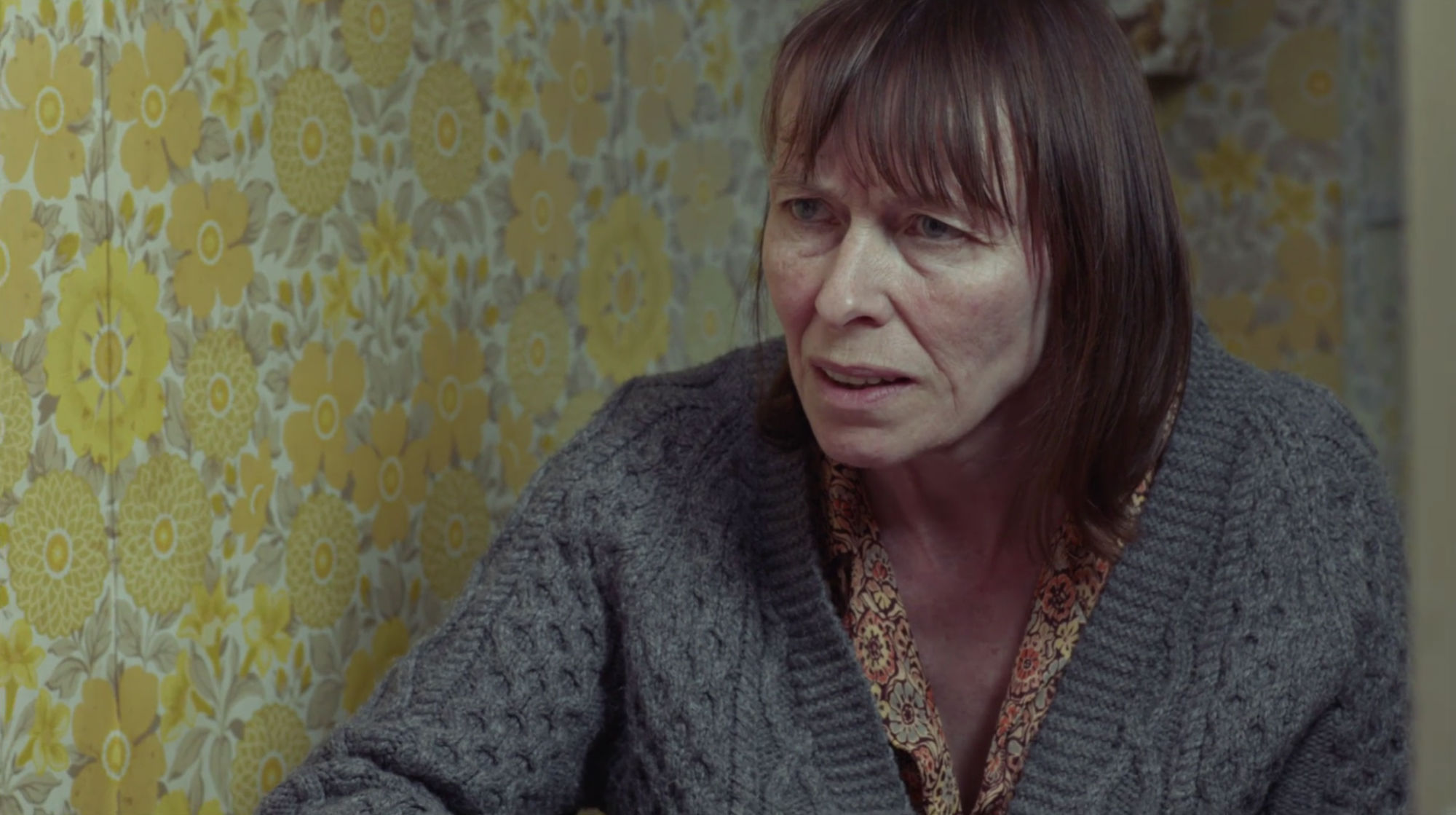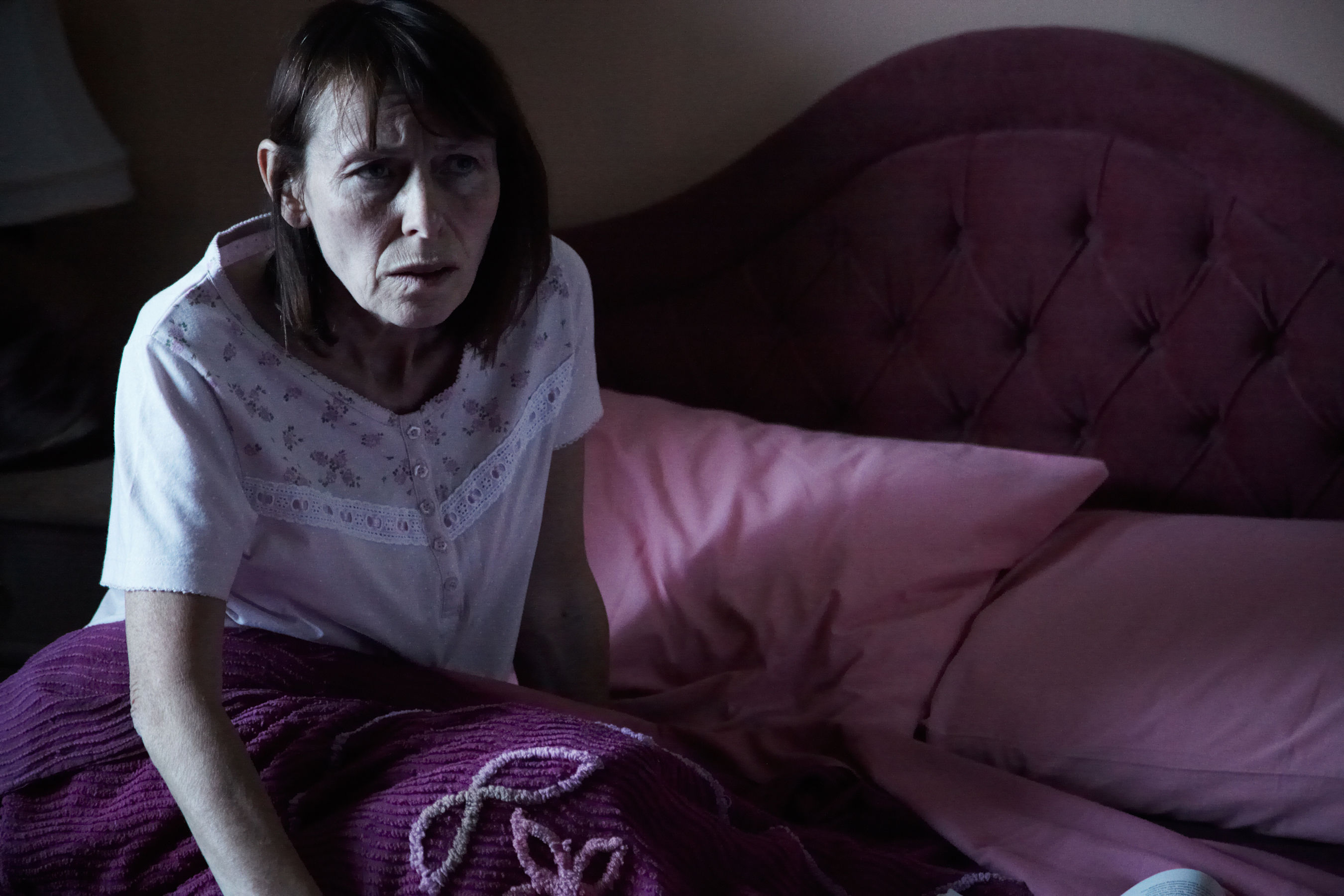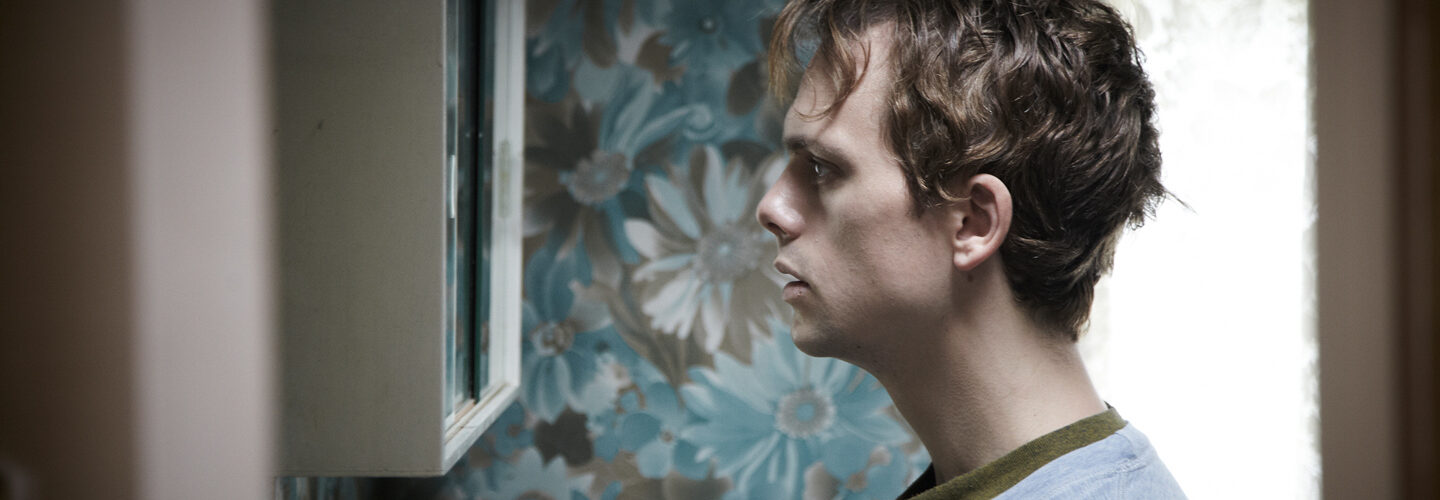
Since May, Directors Notes has had the considerable pleasure of being the online premiere home for Writer/Director/Producer Dee Meaden’s short films. Featuring the diverse stories of a rural, religious community disrupted by a provocative newcomer (Good News), a young man consumed by the guilt of his drunken actions (Mark), an actor who takes to the streets as a homeless man in order to hone his craft (An Actor), and the secluded, claustrophobic life of a codependent brother and sister (Sibling). Today’s poignant tale of a young man with learning difficulties determined to crack the code of a trite birthday card greeting Some Things Mean Something, marks the fifth and final film in our Dee Meaden shorts series. We sat down with Dee to talk about the dramatic importance of the small moment coupled with an unhurried editing style and to reflect on the experience of sharing her body of work with the online audience.
How did you come to craft the character of Tony, a perpetual manchild due to the fact of his learning difficulties?
Tony comes from lots of different experiences or observations, the character really doesn’t come from research. When we were beginning to film that was something I suppose I was feeling my way with. I had thought, should I research this character? Should I become extremely informed about people that suffer learning difficulties/disabilities? But it just didn’t feel right to do that. What felt right was to follow instinct.
I realised that the impetus for writing this came from lots of people that I had observed and had experiences with. For instance, there was a man who lived in my neighbourhood when I was a little girl of five or six. He lived on the hill that I lived on so I’d see him walking up and down occasionally. For me, he was absolutely fascinating, attractive, and compelling. He had some kind of learning difficulty, you could see that his interior thoughts were playing out in his mind very strongly. I fell sort of in love with him, as much as you can be when you’re five or six. I suppose I felt a sense of kinship or connection to him until I learned that that was not appropriate. That this wasn’t somebody to be excited about. This was someone, if anything, to be mocked, to be avoided or someone to be pitied.
Maybe I’m stubborn but I feel like I made the film I wanted to make.
I think that in a way, part of the character of Tony comes from that and my feeling of connection. My feeling that I was an oddity too or that I was an outsider. And from later on in life, there was a friend of mine in Mexico whose brother was schizophrenic. He was about 40 and was friends with all the local kids of about 12 and 13. So the scene in the film where Tony’s friends with the kids and he brings them beer comes directly from that experience. That was very poignant because his mom told me that every few years it would be a new set of kids. They would outgrow him. The things that were really exciting to them, like beer or cigarettes, they’d be able to get themselves so he’d lose his power in the group and have to find a younger group. So the character is drawn from different moments like that I suppose.


Stories featuring characters like Tony tend to go to much darker places than we see here, which is perhaps why I felt a sense of foreboding whilst watching the film. Were you intentionally playing on that audience expectation of tragedy?
That’s interesting, but it’s something I only noticed myself in the audience screenings. That sort of sinister feeling isn’t something I planned or was aware of when making the film. I was given some advice to make the film more dramatic, to maybe make it more traditional. Bring that kind of tension to a head and for Tony to be attacked or for there to be violence in the film. I knew I wasn’t interested in that. The focus is really on what’s going on inside Tony’s head and the emotional exchanges and power dynamics. I was really surprised to see how much of that tension that something dark or shocking is going to happen is in there. For me, it does but it’s on a very small emotional level.
Some Things Mean Something was funded by Film London, did they have any concerns about you deploying the more experimental production process you developed when making Sibling on a larger project?
Yeah, my working practice was something that was discussed but they were entirely on board with that. I think because they’d seen clips of Sibling they understood that it could work. They were more concerned that I was going to write, direct and produce the film myself, that I’d wear all those hats. But in terms of just my creative approach, they were entirely behind it to their credit.
I find prep slightly frustrating because I just want to be on set, that’s where I’m in my element.
The writing, directing and producing, how was that from your perspective?
For me, it’s the easiest route. I couldn’t do it for a feature but for short, it feels really direct to have that process. I think that is because I’ve produced for so long. There are people who were critical of the edit and said perhaps I should have had another pair of eyes on it, such as an executive producer. Maybe I’m stubborn but I feel like I made the film I wanted to make and I’d rather have that process. I find prep slightly frustrating because I just want to be on set, that’s where I’m in my element. So I’d rather have that frustration at myself that those elements aren’t in place, rather than at someone else, especially on a project this big. So, for me, it worked, I enjoyed having those three roles.


Did you go the traditional casting agent route or did you already have the actors in mind when writing the script?
I didn’t write the script for the actors that have ended up playing the roles. The idea for these characters actually goes back a long, long time. I tried to write a feature length version of the script years ago. I knew very little about writing back then so that didn’t go so well. When I came to write it as a short, I already had the essence of those characters in place.
In terms of the route I went with casting, it was a bit of a mix. I worked with Kharmel Cochrane as casting director and we struggled with finding a Tony. The strange thing is that Robert Boulter, who plays Tony in the film, is somebody I’d met by chance in an acting workshop which was put on by Film London for this project. He’d been assigned to me and was the first person that I’d ever seen reading it. I thought he was incredible but because this was right at the beginning of the process, and I was already beginning to work with Kharmel, he was kind of put to one side. I was thought that maybe everyone was going to respond to the script in the way that Rob did but as we went on through the casting process, they never seem to be a fit. I kept remembering the incredible performance that he gave immediately in the workshop with like, three minutes of chat with me.
One thing perhaps I should have mentioned when we’re talking about the character of Tony is that it was difficult for some people that I didn’t want to name what condition Tony has. To me, the idea of saying he has autism or Asperger syndrome or whatever was a kind of limiting idea. As a viewer, I feel that if somebody tells me that, I have the idea that I understand that character, but actually, I don’t because I don’t know what it means to have autism. So I really didn’t want to name it.
Rob asked me the question, like almost everyone else, as a kind of initial way into the character. As soon as I explained he got that immediately and he approached it entirely from the inside out. I just thought that was exceptional. So we kind of came full circle. With Tilly Vosburgh although I didn’t write it with her in mind, she’s someone I thought of right at the start of the casting process after seeing her in a film called Darklight.

Although this is clearly Tony’s story, there are several comments from Rosa which speak to the frustrations and difficulties of the past which have caused her fatalistic view of the future.
Even though this is somewhat of a snapshot or a portrait of these two, I wanted there to be that weight of their history together. That feeling of her exhaustion or the feeling of all the years, all the time she spent in this kind of perpetual state of caring. I think for her there was the idea that Tony is a perpetual child, one that won’t grow up and the one that you take no joy in. It’s like a never ending project that you can’t succeed at. But at the same time, she can’t let him be free. That was my central idea for Rosa and I suppose my central interest that she wants freedom from him desperately, but she can’t actually let him be free to give herself freedom.
Am I right in thinking that you shot chronologically?
Yeah, pretty much. Because of Tilly’s availability, we had to meddle with some scenes a little bit and change the order. But the last two days were I think, almost entirely chronological. That again is something that came from Sibling where we didn’t have continuity on that project so it made sense to go in order. Again I think that’s become a working practice now. As a director, it’s so much easier but it’s also so much more intense because I feel like I’m living the story as it unfolds before my eyes. I think what it brings to the performances is really strong.
I feel like I’m living the story as it unfolds before my eyes.
The film was shot with the Arri Alexa, how did you come to settle on that camera?
That was the number one choice of my DP Ollie Verschoyle. He wanted to be really ambitious with this film after Sibling, which was shot on a 5D or 7D, out in the middle of nowhere, with just a handful of lenses and literally just him with some homemade lights. It was funny on set because he had the Alexa and a huge array of beautiful lenses, and then he had his homemade lights that were taped up on walls. So it was this mad mix of the two. That all came from him, I think it was an opportunity to work on that scale and to test ourselves with bringing in the more maverick elements of our process.
You ultimately created two cuts of the film – the original 33 minute cut we’re sharing today and a 24 minute cut made specifically for festivals. How difficult did you find it remove a third of the film and how do you feel the two versions differ as representations of your original vision of Tony’s story?
I found it extremely hard and as with Sibling, it’s something we did just to get a version of the film that had a chance of playing at festivals. With this film, in particular, I thought there was something about duration that was very important. Some of my favourite films are films where you often just watch the central character and they’re actually the person doing the least. Tony is a character who is initially baffling and it’s only through staying with him and paying attention to him, in a way that no one in the film does, that we come to understand the profound emotional changes going on in him. I thought it made sense for the audience to have to spend time with this character and to only slowly come to understand him through adjusting to his tempo.
I thought it made sense for the audience to have to spend time with this character.
Some Things Mean Something marks the final film in our five month premiere series of your work. Aside from no longer having to dodge emails from us begging you to release your films online, has the experience of exposing these films to a larger audience been a positive one?
Yes, it’s been a delight! I should have responded to your emails far earlier! You’ve created a place for these films to exist as a body of work which feels really satisfying and meaningful for me and it’s meant that the dialogue I’ve had with people about them is much more complex as it’s not about one film in isolation but about themes that keep resurfacing across several films made years apart. Thank you!
This sadly brings our Dee Meaden premiere series to a close. If you’ve missed any of the previous films you can catch them all and our accompanying discussions with Dee here.


